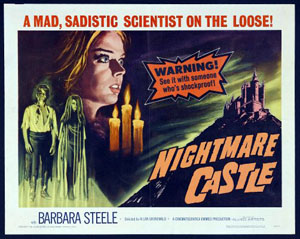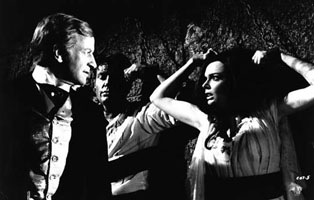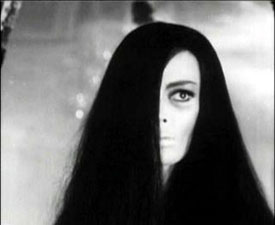After the success of Mario Bava’s inaugural masterpiece Black Sunday, Barbara Steele, who if you didn’t realize is actually British, found more work in Italy than in her homeland. It’s odd when you think about it, because at the same time, the 60s were when British horror studio Hammer was at its peak (and Amicus was starting to build steam), and  as such you’d think Steele would have been beating off UK producers with a stick. But that wasn’t the case, and she found her biggest successes in Italy, starring in countless gothic horror films inspired by the film that made her a star. Director Mario Caiano’s Nightmare Castle (alternately known as The Faceless Monster and Night of the Doomed) came along near the end of the Italian gothic horror cycle, but that doesn’t necessarily mean it doesn't stand on its own merits.
as such you’d think Steele would have been beating off UK producers with a stick. But that wasn’t the case, and she found her biggest successes in Italy, starring in countless gothic horror films inspired by the film that made her a star. Director Mario Caiano’s Nightmare Castle (alternately known as The Faceless Monster and Night of the Doomed) came along near the end of the Italian gothic horror cycle, but that doesn’t necessarily mean it doesn't stand on its own merits.
While Muriel may be married to Dr. Stephen Arrowsmith, she isn’t exactly faithful. She has a lover named David, one of the castle’s servants, and whenever Dr. Arrowsmith is away, the two of them play. This is something that the good doctor is privy to, and one evening he goes through the charade of leaving only to be given a signal by another of the castle’s servants, an old woman named Solange, once Muriel and David have taken to the greenhouse for some fun. Dr. Arrowsmith is not amused, and after knocking them both out, chains them up in the dungeon below the castle and tortures them with whips, hot pokers, and starvation, which eventually leads to their deaths. He removes their hearts and stores them away under a statue in the castle, and incinerates the rest of their remains, using the ash as soil for a house plant.
We soon find out that regardless of Muriel’s infidelity this was the plan all along, as Muriel was a rich woman and Dr. Arrowsmith’s true love, the elderly Solange who has had her youth restored thanks to a transfusion of Muriel’s blood, was in on things. Things don’t go as smoothly as planned however, as it’s soon discovered that Muriel had changed her will, leaving all of her money and possessions to her step-sister Jenny, who is currently being held at a mental institution. Believing that a mentally unstable person can be easily manipulated, Dr. Arrowsmith marries Jenny and moves her into the castle. The plan? To have Solange spike her drinks with a hallucinogenic liquid, make her go out of her mind, and have all of her wealth fall upon them. The first night is a complete success, as Jenny hears voices and relives the final moments of her step-sister Muriel's life. But when Dr. Arrowsmith and Solange realize they spiked her drink with the wrong liquid, something that’s completely harmless, they start to wonder if the ghosts of Muriel and her lover may be back for revenge…
It’s hard to argue that Nightmare Castle isn’t full of cliché’s and elements that had become almost stock at the point in which it was released, but it has a bizarre aura about it that makes it stand out in a way that others don’t. Take for instance the torture scene early on in the film; while it’s quite tame by today’s standards, there aren’t many films I can pin point from the mid-60s that featured Mark of the Devil-style torture like hot pokers and in-your-face  whippings. There’s also Jenny’s first nightmare, which is an absolute marvel of ethereal atmosphere. Shot in a fashion that harkens back to early cinema from the 20s and 30s, with a fair-share of haze over the imagery, it evokes a surreal, nightmarish feeling that is impossible to ignore. In fact, I found it to be the highlight of the film.
whippings. There’s also Jenny’s first nightmare, which is an absolute marvel of ethereal atmosphere. Shot in a fashion that harkens back to early cinema from the 20s and 30s, with a fair-share of haze over the imagery, it evokes a surreal, nightmarish feeling that is impossible to ignore. In fact, I found it to be the highlight of the film.
Director Mario Caiano hits all the right notes when it comes to setting the mood, and while none of the sets particularly stand out (outside of the aforementioned torture dungeon), he does a nice job of creating a palpable, believable gothic aesthetic, and the wonderful cinematography certainly helps matters as well. Also adding to the film’s spirit is composer Ennio Morricone; Nightmare Castle was actually his first attempt at scoring a horror film. While his work here certainly isn’t as memorable or evocative as some of his more famous work, the overpowering organ-heavy interludes give the film an appropriately sinister feel.
Nightmare Castle is far from perfect however, and at 105 minutes, its length is its biggest flaw. There are long, plodding sections of the film, especially in the middle, where almost nothing of interest happens, which definitely does a disservice to any tension that may have been built up throughout the first act. You’ll get to see characters casually strolling around the castle’s corridors on more the one occasion, and it feels as if during these segments even Caiano himself didn’t know where he was going. The other major problem in the film is the hackneyed subplot with Solange and the restoration of her youth. It’s pretty much never explained how it works, and I also wondered why Dr. Arrowsmith was interested in the first place; was she originally young and beautiful and then afflicted with some disease? I highly doubt he’d have fallen in love with her in her original, haggard state. This all should have been left on the cutting room floor when taking into account how underdeveloped the plot thread is, and really, dreams of wealth and prosperity would have been more than enough motivation for the doctor to murder his wife.
Even with its weaknesses, Nightmare Castle is required viewing for fans of gothic Italian horror, especially with the chaotic symphony of paranormal madness that closes out the film and the wonderful dual performance courtesy of Barbara Steele. This makes for great late night fun.

Severin Films comes to the rescue of Nightmare Castle, saving it from countless inferior public domain releases. Presented in 1.66:1 anamorphic widescreen, this is the best the film has ever looked. It’s restored from the original HD negative, and it shows. Black levels are solid, which is important to the mood in a film such as this, definition is quite nice, and outside of some minor print damage and a few instances of noticeable aliasing, there’s little to complain about. The included English mono is nice and clear, free of any distortion, and the dialogue is easily understood. It’s unfortunate that the Italian track wasn’t included for those that prefer it, but since Steele’s actual vocals are used in the English language track, I'm satisfied.
The most notable extra on the disc is a half hour interview with Barbara Steele, in which she discusses much of her career at length, from being discovered, her work in films like Bava’s Black Sunday and Fellini’s 8 ½, her popularity in the 60s, all the way down to her appearance in Cronenberg’s Shivers. She seems to enjoy reminiscing, and doesn’t seem bothered at all about being best known as a Scream Queen. A 15 minute interview with director Mario Caiano is also included. Most of the conversation is centered on his work on Nightmare Castle, including the troubles he had during production as well as his admiration for Ms. Steele. It's also pretty hilarious to watch one of his cats pop up at random and start trying to eat his hand! The disc is rounded out with both the UK and (the very hokey) US trailers for the film.
Please feel free to discuss "Nightmare Castle" here, in our forums!

